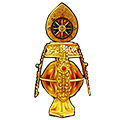The Four Noble Truths
We know that Buddha Shakyamuni began and ended his preaching with the teaching of the Four Noble Truths. The Four Noble Truths are known as Suffering, Accumulation [of Suffering], Extinction, and Path. When I was giving a discourse on the Heart Sutra, I also commented on this topic ?`There is no suffering, no origination of suffering, no extinction of suffering, and no path.` There is a mistake in regard to the order of these Four Truths. Perhaps the translator slipped and got the order mixed up. The proper order should be: Accumulation, Suffering, Path, and Extinction. Rendered this way, its meaning is: Accumulate all the Sufferings and go quickly to walk on the Path to enter into the Extinction of Suffering [Nirvana].
Life is a process of suffering because of its inherent nature of Impermanence, of transformations. Ordinary people cannot tolerate Impermanence. To them, the sudden disappearance of an acquaintance who was with them the day before is a source of pain. However, an Enlightened Being realizes that such is the way things are and thus he or she will be able to accept the transformations. The Buddhadharma recognizes that Impermanence or transformation is an inherent characteristic of the laws of transmigration and karma. The Four Noble Truths taught by the Buddha point out that when one contemplates on all sufferings and thus enters into the spiritual process, one will reach Nirvana. Upon Realization, the Four Noble Truths of `Accumulation, Suffering, Path, and Extinction` are transmuted into the condition known as `Permanence, Bliss, Identity, and Purity.` `Permanence` is residing permanently in the True Condition, which is tantamount to the state of Self-Mastery. `Bliss` exists because of Freedom. `Identity` refers to the True Self, which is infinitely expansive and is not the egotistic self. `Purity` refers to the untainted and unqualified nature of the True Condition. So the Four Noble Truths also mean `Permanence, Bliss, Identity, and Purity` ?a condition of Freedom and Bliss wherein one is continually identified with the Pure, True Self and recognizes all phenomena to be a transcendental game of the Universe.
The first teaching that the Buddha gave was this doctrine of the Four Noble Truths, which includes the concept of Impermanence. In the statement exclaimed by the Buddha ?`Between Heaven and Earth, only I am the Most Supreme` ?the `I` refers to the infinitely expansive Universal Consciousness which is also the True Condition. You must remember that this `I` does not refer to a single individual. Actually the most important significance of the teaching of the Four Noble Truths lies in its transformation from `Accumulation, Suffering, Path, and Extinction` to `Permanence, Bliss, Identity, and Purity.` Various points of view arise as to how one can best effect this transformation. Here also lies the cause of the division of the Buddhadharma into the three existing Vehicles, with each one adhering to its own `Right View.`
Hinayana Buddhism adheres to the Right View of Impermanence and proposes Renunciation as the solution. Mahayana Buddhism adheres to the Right View that the Absolute Reality is one that transcends `subjectivity, objectivity, all phenomenal worlds, and time` 𩣱he same view as set forth in the Diamond Sutra. Mahayana Buddhism also advocates the concept of Six Paramitas (Six Perfections) as the means to achieve this goal. Vajrayana Buddhism adheres to the Right View that there is inherently no separation between oneself and the Buddha. You are the Buddha and I am the Buddha. This Truth is realized when the Offspring Light and the Mother Light merge into each other. Vajrayana Buddhism also holds the view that, through the blessing or `grace` of a Realized Being, one can directly experience this Condition wherein one and others are inherently the same as the Buddha.
This concludes today`s discussion on `Practice and Realization` and `The Four Noble Truths.` Yesterday I discussed `Faith, Comprehension, and Impermanence.` I hope you all gain a tacit understanding from these discussions.
Om Mani Padme Hum.




